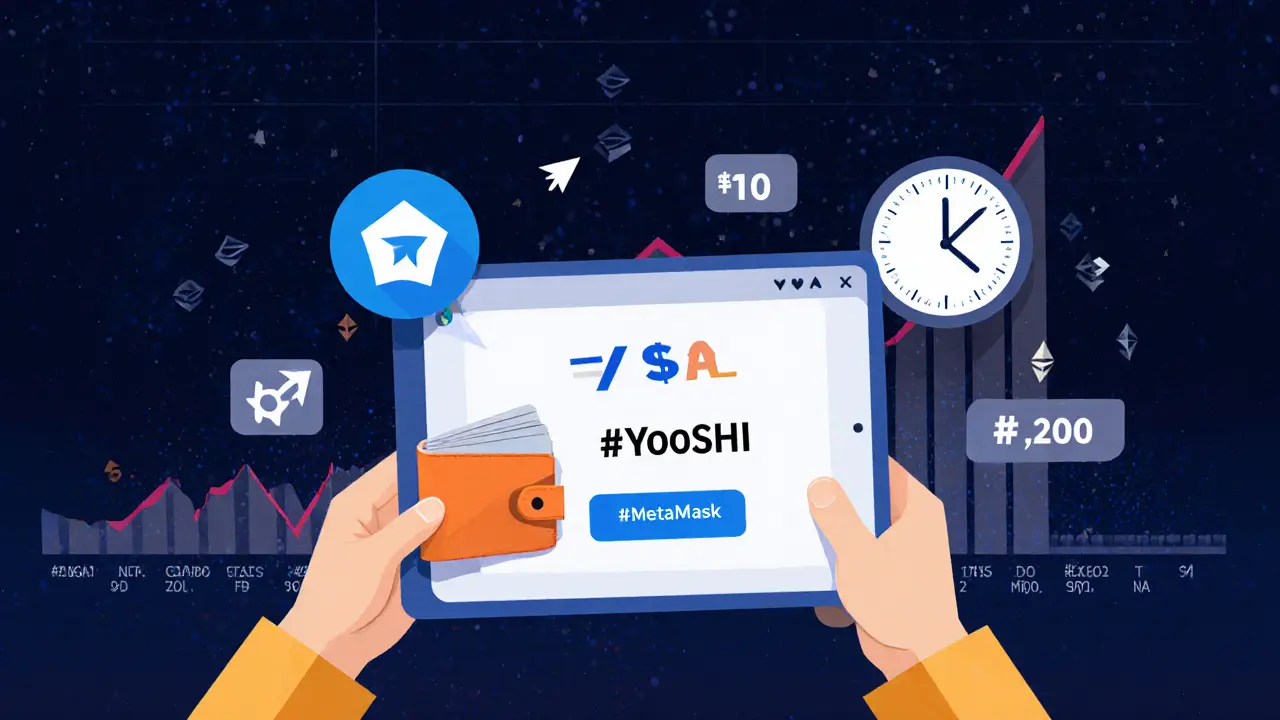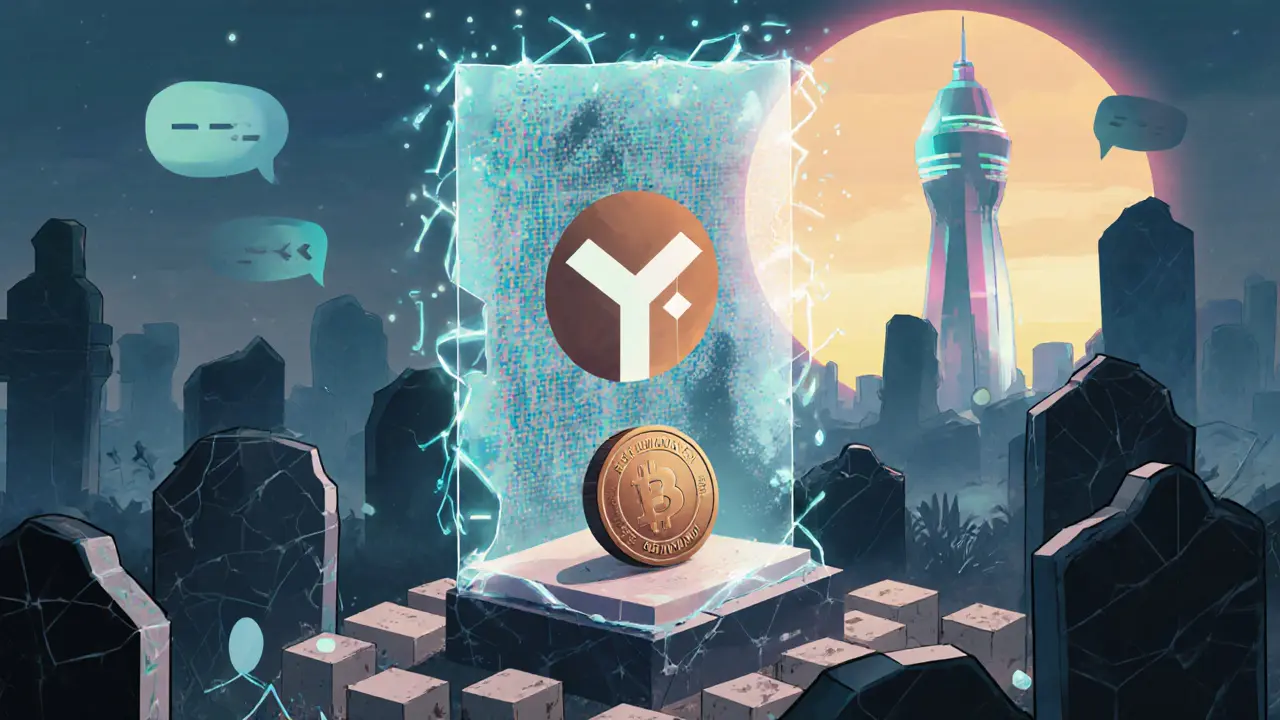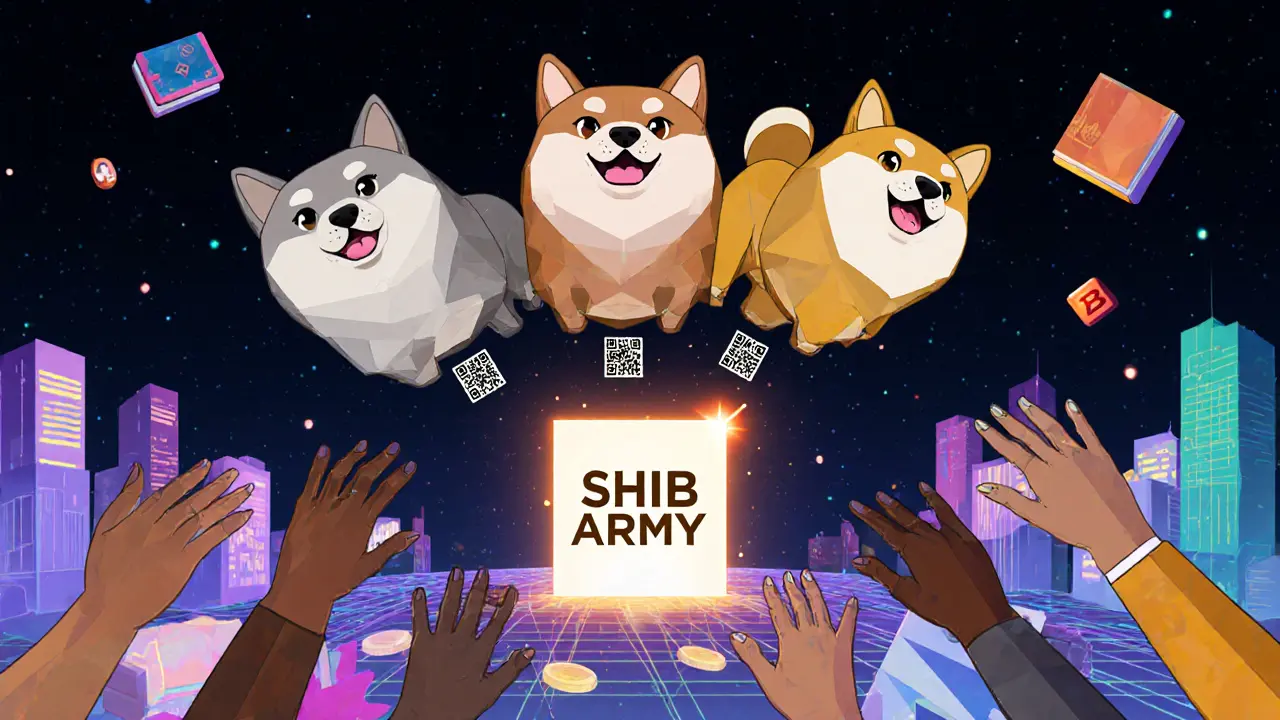YOOSHI SHIB ARMY NFT Value Estimator
NFT Rarity Tier
The YOOSHI SHIB ARMY NFT collection had three tiers: Bronze, Silver, and Gold. Each tier had different rarity levels, with Gold being the rarest.
Current Value Estimate
Important Note
Based on data from NFT marketplaces like OpenSea and LooksRare, most YOOSHI SHIB ARMY NFTs have little to no market value today. This calculator provides a conservative estimate based on historical sales data from 2021-2023.
Many NFTs have been sold for under $1 due to the lack of utility and active marketplace support.
Back in May 2021, the crypto world was buzzing. NFTs were exploding, memecoins ruled the headlines, and the Shiba Inu community - known as the SHIB ARMY - was growing faster than anyone expected. That’s when YooShi dropped its SHIB ARMY NFT airdrop. It wasn’t just another free token giveaway. It was a carefully timed, community-driven event tied to CoinMarketCap and built on Binance Smart Chain. If you were part of it, you got a digital collectible. If you missed it, you missed a moment in crypto history.
What Was the YOOSHI SHIB ARMY NFT Airdrop?
The YOOSHI SHIB ARMY NFT airdrop was a four-day event that ran from May 27 to May 31, 2021. It gave away exclusive NFTs to people who had already joined the YooShi community and whitelisted their Binance Smart Chain wallet addresses. No buying. No minting fees. Just claiming what was already reserved for you.
The NFTs came in three tiers: Bronze, Silver, and Gold. Each had different rarity levels, with Gold being the rarest. These weren’t just pictures of dogs - they were digital membership cards to the SHIB ARMY. The project leaned hard into the culture of the Shiba Inu community, using the term "SHIB ARMY" to create a sense of belonging. If you held one of these NFTs, you weren’t just a holder - you were part of something bigger.
The airdrop wasn’t random. You had to earn your spot. To qualify, you needed to follow two steps: join the YooShi Telegram channel and retweet CoinMarketCap’s official post using the hashtags #YOOSHI and #CMC. That’s it. No complex KYC, no credit card, no middleman. Just community participation.
How Did You Claim the NFT?
Claiming your NFT was simple - if you did the prep work. First, you had to have a Binance Smart Chain-compatible wallet. MetaMask was the most common choice. You needed to add the BSC network manually if you hadn’t already. Then, you had to whitelist your wallet address during the pre-registration period, which ended just before the airdrop went live.
Once the clock hit May 27 at 1 PM UTC, the claiming portal opened at yooshi.io. You’d connect your wallet, and if you were eligible, your NFT would appear instantly. The whole process took less than a minute. No gas wars. No failed transactions. The team had clearly learned from the chaos of other NFT launches that year.
There was no rush to mint. No countdown timer that made you panic. But there was a hard deadline: May 31 at 1 PM UTC. After that, the portal closed. No extensions. No second chances. People who waited until the last hour reported delays, but those who claimed early got it done without stress.
Why Binance Smart Chain?
YooShi didn’t pick Ethereum. It picked Binance Smart Chain (BSC) for one big reason: cost.
In May 2021, Ethereum gas fees were hitting $100+ per transaction. For a free airdrop, that made zero sense. BSC, on the other hand, had gas fees under $0.10. It was fast, cheap, and already home to a massive user base. Most SHIB ARMY members were already using BSC wallets because that’s where the SHIB token lived.
By sticking to BSC, YooShi made sure the airdrop was accessible to regular people, not just crypto whales. You didn’t need a $5,000 Ethereum wallet. You just needed a phone and a free MetaMask setup. That’s what made this airdrop feel inclusive - not elitist.

What Was the Bigger Picture?
The SHIB ARMY NFT airdrop wasn’t just about giving away digital art. It was a marketing engine. YooShi partnered with CoinMarketCap - one of the biggest crypto data platforms - to spread the word. That gave the project instant credibility. It wasn’t some anonymous Telegram group pushing a sketchy token. It was a verified project with real visibility.
The timing was perfect. May 2021 was the height of the NFT boom. Bored Ape Yacht Club was selling for millions. CryptoPunks were breaking records. People were buying digital monkeys for $100,000. In that climate, a free NFT from a project tied to Shiba Inu felt like a golden ticket.
YooShi also tied its tokenomics to the broader Shiba Inu ecosystem. The total supply of YooShi tokens was over 45 trillion, and the project encouraged burning tokens to reduce supply - a move that mirrored the deflationary strategy of SHIB itself. The idea was simple: the more people joined, the more value could be created for everyone.
What Happened After the Airdrop?
Here’s the hard truth: most people forgot about these NFTs.
There was no official marketplace for trading them. No floor price was ever set. No major exchange listed them. The NFTs sat in wallets - some still there, others sold off for pennies on obscure NFT marketplaces like OpenSea or LooksRare. Without utility, they lost their shine.
Unlike other NFT projects that later added games, staking, or access passes, YooShi didn’t build on the airdrop. There were no follow-up drops. No roadmap updates. The Telegram channel went quiet. The website stayed up, but it stopped updating. The NFTs became digital relics.
By 2023, the focus of the Shiba Inu ecosystem had shifted to Shibarium - a Layer 2 blockchain built for DeFi and gaming. New airdrops were tied to Shibarium staking, not NFTs. The original SHIB ARMY NFTs were left behind, like VHS tapes in a world of streaming.

Could Something Like This Happen Again?
Maybe. But not like this.
Today’s airdrops are smarter. They’re tied to real utility: access to games, governance rights, or staking rewards. Free NFTs alone don’t cut it anymore. The market is saturated. People are tired of collecting JPEGs with no purpose.
YooShi’s airdrop worked because it was simple, timely, and community-focused. It didn’t overpromise. It didn’t claim to be the next Bitcoin. It just gave people something cool to hold - a badge of honor in the SHIB ARMY.
That’s the lesson. If you’re building a crypto project today, don’t just give away NFTs. Give people a reason to stay.
Final Thoughts
The YOOSHI SHIB ARMY NFT airdrop was a snapshot of crypto in 2021: chaotic, exciting, full of hope. It wasn’t perfect. It didn’t last. But for a few days, it brought thousands of people together under one banner: the SHIB ARMY.
If you still have that NFT, keep it. It’s a piece of history. If you missed it, don’t regret it. The crypto world moves fast. The next big thing isn’t a free NFT - it’s a real use case that solves a problem. And that’s what matters now.
Was the YOOSHI SHIB ARMY NFT airdrop free?
Yes, the airdrop was completely free. You didn’t pay anything to claim your NFT. The only requirement was joining the YooShi Telegram channel and retweeting CoinMarketCap’s post with the hashtags #YOOSHI and #CMC during the pre-registration period.
Did you need a specific wallet to claim the NFT?
Yes. You needed a Binance Smart Chain (BSC)-compatible wallet like MetaMask. Ethereum wallets wouldn’t work. You also had to whitelist your BSC address before the airdrop started on May 27, 2021.
How many NFTs were distributed in the airdrop?
The exact number of NFTs distributed isn’t publicly confirmed, but the total YooShi token supply was 45,896,736,161,754. The NFT collection had three tiers - Bronze, Silver, and Gold - with limited quantities per tier. Only those who completed the whitelisting process received one.
Can you still claim the YOOSHI SHIB ARMY NFT today?
No. The claiming portal on yooshi.io closed on May 31, 2021, after the four-day window. There is no official way to claim these NFTs anymore. Any site offering to help you claim them now is likely a scam.
Are these NFTs worth anything today?
Most have little to no market value. A few are listed on NFT marketplaces like OpenSea, but sales are rare and prices are extremely low - often under $1. The NFTs have no active utility, marketplace, or community support anymore. Their value is mostly sentimental or historical.
Is YooShi still active today?
The original YooShi project has largely been absorbed into the broader Shiba Inu ecosystem, particularly the Shibarium Layer 2 network. Current efforts focus on DeFi, gaming, and Shibarium-based airdrops. The SHIB ARMY NFT project is no longer actively maintained.
Why did the YooShi NFT airdrop fail to last?
It lacked long-term utility. After the initial hype, there was no roadmap for how the NFTs would be used - no games, no staking, no access to future drops. Without ongoing value, interest faded. Most holders moved on to newer projects, and the community lost momentum.
How did CoinMarketCap help with the airdrop?
CoinMarketCap acted as a promotional partner. To qualify, participants had to retweet their official post using #YOOSHI and #CMC. This gave the airdrop massive exposure to CoinMarketCap’s millions of users, lending credibility and driving sign-ups.

David Hardy
November 24, 2025 AT 02:35Emily Michaelson
November 25, 2025 AT 08:43Jenny Charland
November 26, 2025 AT 07:29John Borwick
November 28, 2025 AT 01:25they didn’t overpromise. they just gave us a moment. and honestly? that meant more than a million-dollar NFT ever could.
Belle Bormann
November 30, 2025 AT 00:49stuart white
December 1, 2025 AT 15:08Linda English
December 2, 2025 AT 11:52preet kaur
December 4, 2025 AT 08:41jocelyn cortez
December 5, 2025 AT 03:45Amanda Cheyne
December 6, 2025 AT 20:33Anne Jackson
December 6, 2025 AT 23:09Lisa Hubbard
December 8, 2025 AT 19:18Gus Mitchener
December 10, 2025 AT 15:29Dave Sorrell
December 11, 2025 AT 11:46